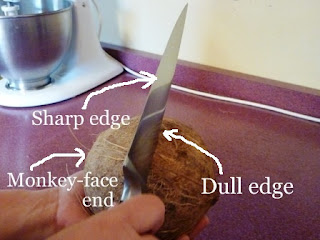In
Part 1, I wrote about selecting and opening coconuts. After the coconut is open though, how do you use it?
If you're interested in using fresh coconut, you need a way to grate it.
I love cooking with coconut. Fresh coconut, that is. IMHO, the dry, white, sugary shreds of sawdust sold in bags are not fit to bear the name of coconut. I've heard that they're the pulp that's left over after the oil and moisture have been extracted for coconut milk. I can believe that because they don't even compare to the fresh stuff.
 |
Bench-type grater
$16.50 from GroceryThai.com |
|
In the past, I'd use a table knife to extract thin slices (about 1/2" wide) at a time. (
Note: Please, don't use a sharp knife. I did that once, and the knife slipped, giving me a 1 1/2 - 2" long gash in my palm) Then I'd put all my slices in my Vitamix blender and pulse it to "grate" them. However, I'd always long for a tool like the one I'd seen used on Guam.
It was basically a bench or a long board with a serrated metal disk at one end. A person would put a bowl or plate on the ground under the disk. Then, they would sit on the bench/board and grate the coconut on the disk. The grated meat would fall to the plate. I've seen people grate whole coconuts efficiently in a matter of a few minutes.
I began hunting for coconut graters/shredders. I saw some pretty cool gadgets online, but in the end I decided to go back to basics and ordered three simple tools from a site called
GroceryThai.com.
 |
| Exhibit A |
Exhibit A: This item has blades on both ends. One is for making fine gratings. The other is for wider shreds. It was only $4.50, which probably accounts for the very flimsy construction of this tool. Even the color used to dye the tool was coming off on my hand.
As for performance, it took some real pressure and wrist strength to get it to work. However, I couldn't help feeling that any significant amount of pressure would break the tool. Since I didn't want to injure myself, I gave up almost immediately.
 |
| Exhibit B |
Exhibit B: This grater was $4.99. Although it was only 49 cents more, there was a noticeable improvement in construction. For starters, the blade felt like it wasn't going to fly off and hit me in the eye.
The round, serrated blade that you see worked well. However, it required considerable wrist strength, and I had to keep stopping in order to rest.
Although you can't see it in this photo, there is a scraping tool for wider shreds on the other side of the blade. I found that tool useless. I couldn't get enough purchase on the meat to make any shreds.
Overall, I would not recommend this tool. It hurt my wrist. Also, I have big hands, so I kept worrying that I would skin my knuckles on the scraper.
 |
| Exhibit C |
Exhibit C: This item was listed as a tabletop grater for $11.50. I debated between getting this item or the bench you see pictured at the top of this screen. The difference in cost was minimal, but ultimately, I decided a potentially lethal piece of furniture around small children was not altogether prudent. Also, with limited storage space, this one could hang on the wall.
It's a very sturdy tool, but I'm not sure how it could be used on the tabletop. Maybe you could clamp it. Otherwise, I'd be afraid of the wood slipping.
I ended up putting it on a small child-sized chair and sitting on it, just like I remember from my days on Guam. It worked
beautifully! I grated half a coconut in under 2 minutes -- sure beats all the work of removing the coconut from the shell with a knife. (
Note: There is a special tool available for removing all of the coconut meat in one piece. But if I'm going to grate it anyway, I think this is just as fast as removing, cutting, and then grating in a blender.)
I only wish I had read the description better, because I was expecting a bigger board like the ones from my childhood. This was small -- about 12"L x 3"W. However, the essential part of this tool -- the scraper -- is attached by three screws, which I think I can remove and attach to a bigger (and prettier) board. In the meantime, I'm going to drill some holes in this one so that I can put it away.
Now there are other types of graters. Lots of types. If you have a local Indian or Southeast Asian grocer near you, you might want to check in and see what they have. However, as a caution, I would be leery of any that use suction to attach to a countertop. I have some tools like that, and I always end up clamping them down. The last thing you want is some whirling scraping blade flying off the counter.






















